Socioeconomic Drivers of PM2.5 in the Accumulation Phase of Air Pollution Episodes in the Yangtze River Delta of China
Abstract
:1. Introduction
2. Methods
2.1. Sample Area and Cities
2.2. PM2.5 Data
2.2.1. Ambient PM2.5 Concentration
2.2.2. Pollution Day and PM2.5 Episodes
2.3. Method
2.3.1. PM2.5 Episode Indexes
2.3.2. Geographical Detector Model
2.3.3. Factor Detector Indicators
2.3.4. Univariate Linear Regression
3. Results
3.1. Characteristics of PM2.5 Pollution in the YRD
3.2. Characteristics of PMAE
3.3. Impacts of Socioeconomic Factors on PM2.5 Pollution
3.3.1. Pearson Correlation Analysis
3.3.2. PD of SEFs to PMAE
4. Discussion
5. Conclusions
Acknowledgments
Author Contributions
Conflicts of Interest
References
- Dedoussi, I.C.; Barrett, S.R.H. Air pollution and early deaths in the United States. Part II: Attribution of PM2.5 exposure to emissions species, time, location and sector. Atmos. Environ. 2014, 99, 610–617. [Google Scholar] [CrossRef]
- Hwang, S.; Guo, S.; Chi, M.; Chou, C.; Lin, Y.; Lin, C.; Chou, Y. Association between Atmospheric Fine Particulate Matter and Hospital Admissions for Chronic Obstructive Pulmonary Disease in Southwestern Taiwan: A Population-Based Study. Int. J. Environ. Res. Public Health 2016. [Google Scholar] [CrossRef] [PubMed]
- Pascal, M.; Falq, G.; Wagner, V.; Chatignoux, E.; Corso, M.; Blanchard, M.; Host, S.; Pascal, L.; Larrieu, S. Short-term impacts of particulate matter (PM10, PM10–2.5, PM2.5) on mortality in nine French cities. Atmos. Environ. 2014, 95, 175–184. [Google Scholar] [CrossRef]
- Pui, D.Y.H.; Chen, S.; Zuo, Z. PM2.5 in China: Measurements, sources, visibility and health effects, and mitigation. Particuology 2014, 13, 1–26. [Google Scholar] [CrossRef]
- Hao, Y.; Liu, Y. The influential factors of urban PM2.5 concentrations in China: A spatial econometric analysis. J. Clean. Prod. 2016, 112, 1443–1453. [Google Scholar] [CrossRef]
- Han, L.; Zhou, W.; Li, W.; Li, L. Impact of urbanization level on urban air quality: A case of fine particles (PM2.5) in Chinese cities. Environ. Pollut. 2014, 194, 163–170. [Google Scholar] [CrossRef] [PubMed]
- Lin, C.; Li, Y.; Yuan, Z.; Lau, A.K.H.; Li, C.; Fung, J.C.H. Using satellite remote sensing data to estimate the high-resolution distribution of ground-level PM2.5. Remote. Sens. Environ. 2015, 156, 117–128. [Google Scholar] [CrossRef]
- Xu, J.; Yan, F.; Xie, Y.; Wang, F.; Wu, J.; Fu, Q. Impact of meteorological conditions on a nine-day particulate matter pollution event observed in December 2013, Shanghai, China. Particuology 2015, 20, 69–79. [Google Scholar] [CrossRef]
- Chen, Y.; Schleicher, N.; Cen, K.; Liu, X.; Yu, Y.; Zibat, V.; Dietze, V.; Fricker, M.; Kaminski, U.; Chen, Y.; et al. Evaluation of impact factors on PM2.5 based on long-term chemical components analyses in the megacity Beijing, China. Chemosphere 2016, 155, 234–242. [Google Scholar] [CrossRef] [PubMed]
- Aldabe, J.; Elustondo, D.; Santamaría, C.; Lasheras, E.; Pandolfi, M.; Alastuey, A.; Querol, X.; Santamaría, J.M. Chemical characterisation and source apportionment of PM2.5 and PM10 at rural, urban and traffic sites in Navarra (North of Spain). Atmos. Res. 2011, 102, 191–205. [Google Scholar] [CrossRef]
- Yang, A.; Hellack, B.; Leseman, D.; Brunekreef, B.; Kuhlbusch, T.A.J.; Cassee, F.R.; Hoek, G.; Janssen, N.A.H. Temporal and spatial variation of the metal-related oxidative potential of PM2.5 and its relation to PM2.5 mass and elemental composition. Atmos. Environ. 2015, 102, 62–69. [Google Scholar] [CrossRef]
- Salameh, D.; Detournay, A.; Pey, J.; Pérez, N.; Liguori, F.; Saraga, D.; Bove, M.C.; Brotto, P.; Cassola, F.; Massabò, D.; et al. PM2.5 chemical composition in five European Mediterranean cities: A 1-year study. Atmos. Res. 2015, 155, 102–117. [Google Scholar] [CrossRef]
- Hua, Y.; Cheng, Z.; Wang, S.; Jiang, J.; Chen, D.; Cai, S.; Fu, X.; Fu, Q.; Chen, C.; Xu, B.; et al. Characteristics and source apportionment of PM2.5 during a fall heavy haze episode in the Yangtze River Delta of China. Atmos. Environ. 2015, 123, 380–391. [Google Scholar] [CrossRef]
- Amador-Muñoz, O.; Villalobos-Pietrini, R.; Miranda, J.; Vera-Avila, L.E. Organic compounds of PM2.5 in Mexico Valley: Spatial and temporal patterns, behavior and sources. Sci. Total Environ. 2011, 409, 1453–1465. [Google Scholar] [CrossRef] [PubMed]
- Salvador, P.; Artíñano, B.; Viana, M.M.; Querol, X.; Alastuey, A.; González-Fernández, I.; Alonso, R. Spatial and temporal variations in PM10 and PM2.5 across Madrid metropolitan area in 1999–2008. Procedia Environ. Sci. 2011, 4, 198–208. [Google Scholar] [CrossRef]
- Wang, Z.; Fang, C. Spatial-temporal characteristics and determinants of PM2.5 in the Bohai Rim Urban Agglomeration. Chemosphere 2016, 148, 148–162. [Google Scholar] [CrossRef] [PubMed]
- Ye, C.; Chen, R.; Chen, M. The impacts of Chinese Nian culture on air pollution. J. Clean. Prod. 2016, 112, 1740–1745. [Google Scholar] [CrossRef]
- Tallis, M.; Taylor, G.; Sinnett, D.; Freer-Smith, P. Estimating the removal of atmospheric particulate pollution by the urban tree canopy of London, under current and future environments. Landsc. Urban Plan. 2011, 103, 129–138. [Google Scholar] [CrossRef]
- Cheng, Y.; He, K.; Du, Z.; Zheng, M.; Duan, F.; Ma, Y. Humidity plays an important role in the PM2.5 pollution in Beijing. Environ. Pollut. 2015, 197, 68–75. [Google Scholar] [CrossRef] [PubMed]
- Huang, C.; Chen, C.H.; Li, L.; Cheng, Z.; Wang, H.L.; Huang, H.Y.; Streets, D.G.; Wang, Y.J.; Zhang, G.F.; Chen, Y.R. Emission inventory of anthropogenic air pollutants and VOC species in the Yangtze River Delta region, China. Atmos. Chem. Phys. 2011, 11, 4105–4120. [Google Scholar] [CrossRef]
- Wang, H.L.; Qiao, L.P.; Lou, S.R.; Zhou, M.; Chen, J.M.; Wang, Q.; Tao, S.K.; Chen, C.H.; Huang, H.Y.; Li, L.; et al. PM2.5 pollution episode and its contributors from 2011 to 2013 in urban Shanghai, China. Atmos. Environ. 2015, 123, 298–305. [Google Scholar] [CrossRef]
- Zhang, L.; Liu, Y.; Hao, L. Contributions of open crop straw burning emissions to PM2.5 concentrations in China. Environ. Res. Lett. 2016. [Google Scholar] [CrossRef]
- Romero, H.; Ihl, M.; Rivera, A.; Zalazar, P.; Azocar, P. Rapid urban growth, land-use changes and air pollution in Santiago, Chile. Atmos. Environ. 1999, 33, 4039–4047. [Google Scholar] [CrossRef]
- Rooney, M.S.; Arku, R.E.; Dionisio, K.L.; Paciorek, C.; Friedman, A.B.; Carmichael, H.; Zhou, Z.; Hughes, A.F.; Vallarino, J.; Agyei-Mensah, S.; et al. Spatial and temporal patterns of particulate matter sources and pollution in four communities in Accra, Ghana. Sci. Total Environ. 2012, 435–436, 107–114. [Google Scholar] [CrossRef] [PubMed]
- Wang, J.; Ogawa, S. Effects of Meteorological Conditions on PM2.5 Concentrations in Nagasaki, Japan. Int. J. Environ. Res. Public Health 2015, 12, 9089–9101. [Google Scholar] [CrossRef] [PubMed]
- Ross, Z.; Jerrett, M.; Ito, K.; Tempalski, B.; Thurston, G. A land use regression for predicting fine particulate matter concentrations in the New York City region. Atmos. Environ. 2007, 41, 2255–2269. [Google Scholar] [CrossRef]
- Ho, C.; Chan, C.; Cho, C.; Lin, H.; Lee, J.; Wu, C. Land use regression modeling with vertical distribution measurements for fine particulate matter and elements in an urban area. Atmos. Environ. 2015, 104, 256–263. [Google Scholar] [CrossRef]
- Liu, C.; Henderson, B.H.; Wang, D.; Yang, X.; Peng, Z. A land use regression application into assessing spatial variation of intra-urban fine particulate matter (PM2.5) and nitrogen dioxide (NO2) concentrations in City of Shanghai, China. Sci. Total Environ. 2016, 565, 607–615. [Google Scholar] [CrossRef] [PubMed]
- Xu, B.; Lin, B. Regional differences of pollution emissions in China: Contributing factors and mitigation strategies. J. Clean. Prod. 2016, 112, 1454–1463. [Google Scholar] [CrossRef]
- Wang, J.F.; Li, X.H.; Christakos, G.; Liao, Y.L.; Zhang, T.; Gu, X.; Zheng, X.Y. Geographical Detectors-Based Health Risk Assessment and its Application in the Neural Tube Defects Study of the Heshun Region, China. Int. J. Geogr. Inf. Sci. 2010, 24, 107–127. [Google Scholar] [CrossRef]
- Huang, J.; Wang, J.; Bo, Y.; Xu, C.; Hu, M.; Huang, D. Identification of Health Risks of Hand, Foot and Mouth Disease in China Using the Geographical Detector Technique. Int. J. Environ. Res. Public Health 2014, 11, 3407–3423. [Google Scholar] [CrossRef] [PubMed]
- Bi, S.; Ji, H.; Chen, C.; Yang, H.; Shen, X. Application of geographical detector in human-environment relationship study of prehistoric settlements. Prog. Geogr. 2015, 34, 118–127. [Google Scholar]
- Wang, J.; Hu, Y. Environmental health risk detection with GeogDetector. Environ. Model. Softw. 2012, 33, 114–115. [Google Scholar] [CrossRef]
- Feng, J.; Hu, J.; Xu, B.; Hu, X.; Sun, P.; Han, W.; Gu, Z.; Yu, X.; Wu, M. Characteristics and seasonal variation of organic matter in PM2.5 at a regional background site of the Yangtze River Delta region, China. Atmos. Environ. 2015, 123, 288–297. [Google Scholar] [CrossRef]
- Stone, B. Urban sprawl and air quality in large US cities. J. Environ. Manag. 2008, 86, 688–698. [Google Scholar] [CrossRef] [PubMed]
- Martins, H. Urban compaction or dispersion? An air quality modelling study. Atmos. Environ. 2012, 54, 60–72. [Google Scholar] [CrossRef]
- Zhao, X.; Zhang, X.; Xu, X.; Xu, J.; Meng, W.; Pu, W. Seasonal and diurnal variations of ambient PM2.5 concentration in urban and rural environments in Beijing. Atmos. Environ. 2009, 43, 2893–2900. [Google Scholar] [CrossRef]
- The Statistical Yearbook of Shanghai City. Available online: http://www.stats-sh.gov.cn/data/toTjnj.xhtml?y=2014 (accessed on 18 December 2015).
- The Statistical Yearbook of Jiangsu Province. Available online: http://www.jssb.gov.cn/tjxxgk/tjsj/tjnq/jstjnj2015/index_212.html (accessed on 18 December 2015).
- The Statistical Yearbook of Zhejiang Province. Available online: http://www.zj.stats.gov.cn/tjsj/tjnj/ (accessed on 18 December 2015).
- Hu, J.; Wang, Y.; Ying, Q.; Zhang, H. Spatial and temporal variability of PM2.5 and PM10 over the North China Plain and the Yangtze River Delta, China. Atmos. Environ. 2014, 95, 598–609. [Google Scholar] [CrossRef]
- Przybysz, A.; Sæbø, A.; Hanslin, H.M.; Gawroński, S.W. Accumulation of particulate matter and trace elements on vegetation as affected by pollution level, rainfall and the passage of time. Sci. Total Environ. 2014, 481, 360–369. [Google Scholar] [CrossRef] [PubMed]
- Zhao, H.; Tong, D.Q.; Gao, C.; Wang, G. Effect of dramatic land use change on gaseous pollutant emissions from biomass burning in Northeastern China. Atmos. Res. 2015, 153, 429–436. [Google Scholar] [CrossRef]
- Liu, J.; Zhu, L.; Wang, H.; Yang, Y.; Liu, J.; Qiu, D.; Ma, W.; Zhang, Z.; Liu, J. Dry deposition of particulate matter at an urban forest, wetland and lake surface in Beijing. Atmos. Environ. 2016, 125, 178–187. [Google Scholar] [CrossRef]
- Zhao, H.; Jiang, X.; Cui, J. Shifting path of industrial pollution gravity centers and its driving mechanism in pan-Yangtze River Delta. Environ. Sci. 2014, 35, 4387–4394. [Google Scholar]
- Pongpiachan, S.; Kositanont, C.; Palakun, J.; Liu, S.X.; Ho, K.F.; Cao, J.J. Effects of day-of-week trends and vehicle types on PM2.5-bounded carbonaceous compositions. Sci. Total Environ. 2015, 532, 484–494. [Google Scholar] [CrossRef] [PubMed]
- Nagpure, A.S.; Gurjar, B.R.; Kumar, V.; Kumar, P. Estimation of exhaust and non-exhaust gaseous, particulate matter and air toxics emissions from on-road vehicles in Delhi. Atmos. Environ. 2016, 127, 118–124. [Google Scholar] [CrossRef]
- Fang, X.; Li, R.; Xu, Q.; Bottai, M.; Fang, F.; Cao, Y. A Two-Stage Method to Estimate the Contribution of Road Traffic to PM2.5 Concentrations in Beijing, China. Int. J. Environ. Res. Public Health 2016, 13. [Google Scholar] [CrossRef] [PubMed]
- Brassard, P.; Palacios, J.H.; Godbout, S.; Bussières, D.; Lagacé, R.; Larouche, J.; Pelletier, F. Comparison of the gaseous and particulate matter emissions from the combustion of agricultural and forest biomasses. Bioresour. Technol. 2014, 155, 300–306. [Google Scholar] [CrossRef] [PubMed]
- Zhang, Y.; Cao, F. Is it time to tackle PM2.5 air pollutions in China from biomass-burning emissions? Environ. Pollut. 2015, 202, 217–219. [Google Scholar] [CrossRef] [PubMed]
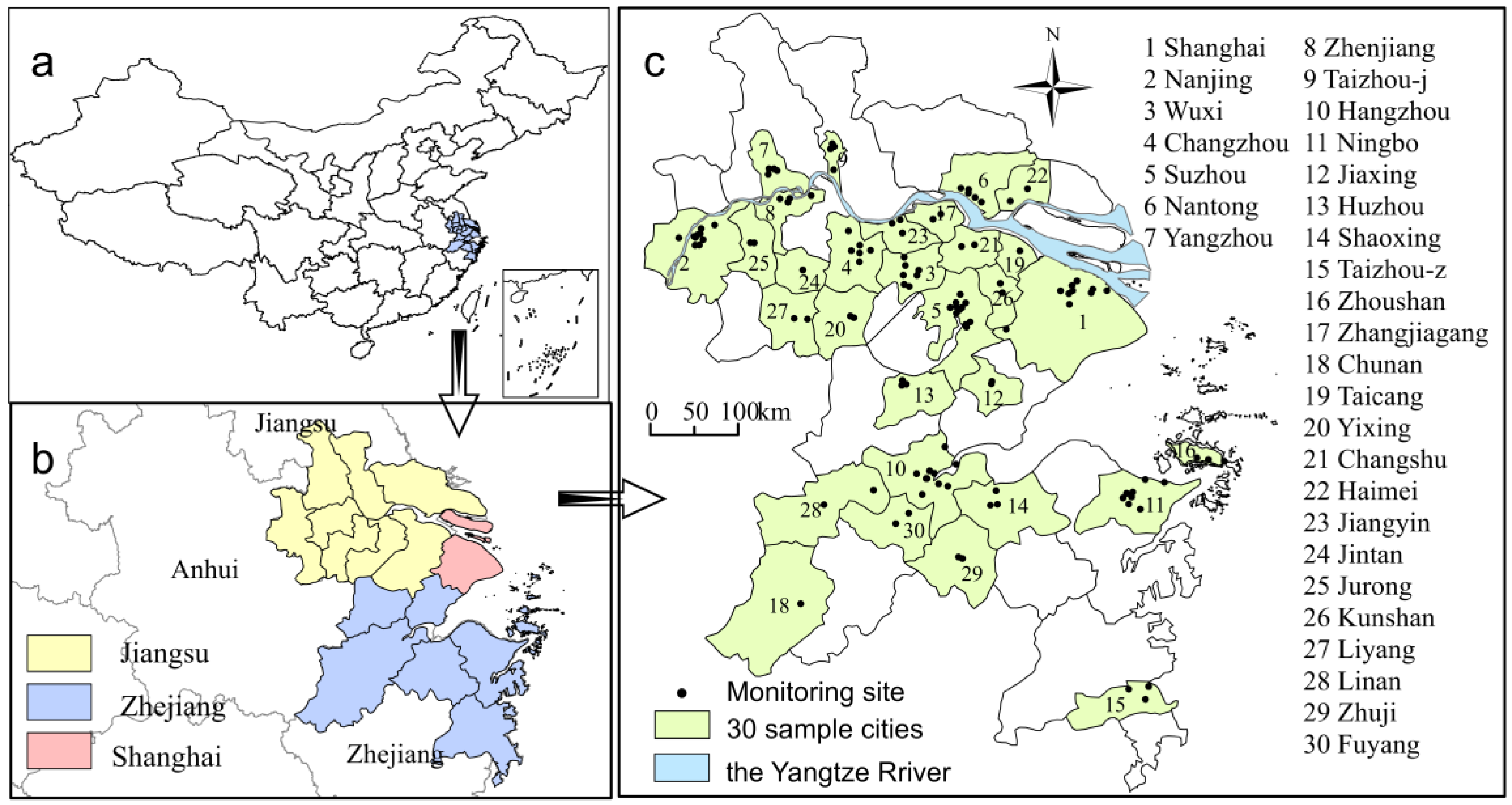
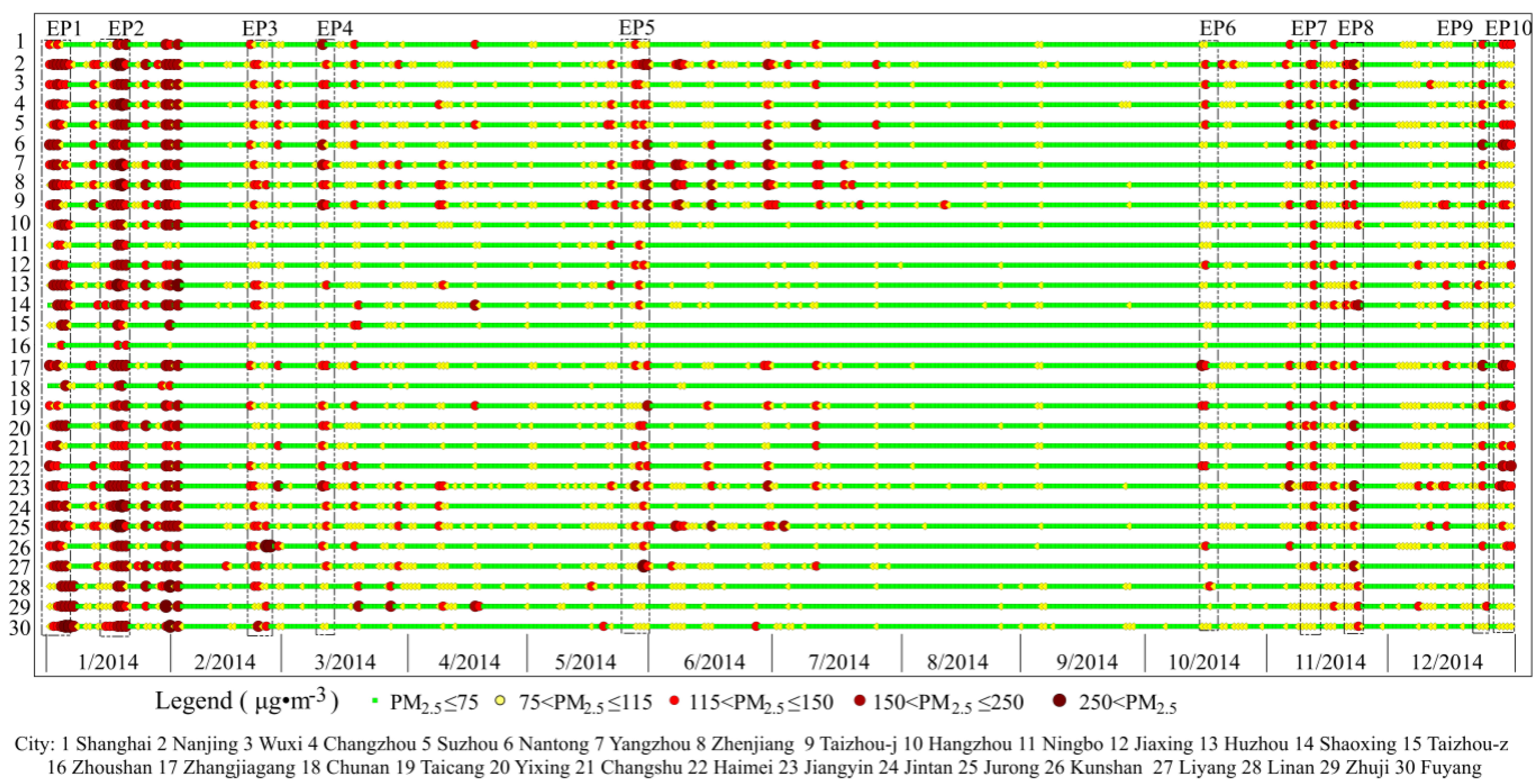
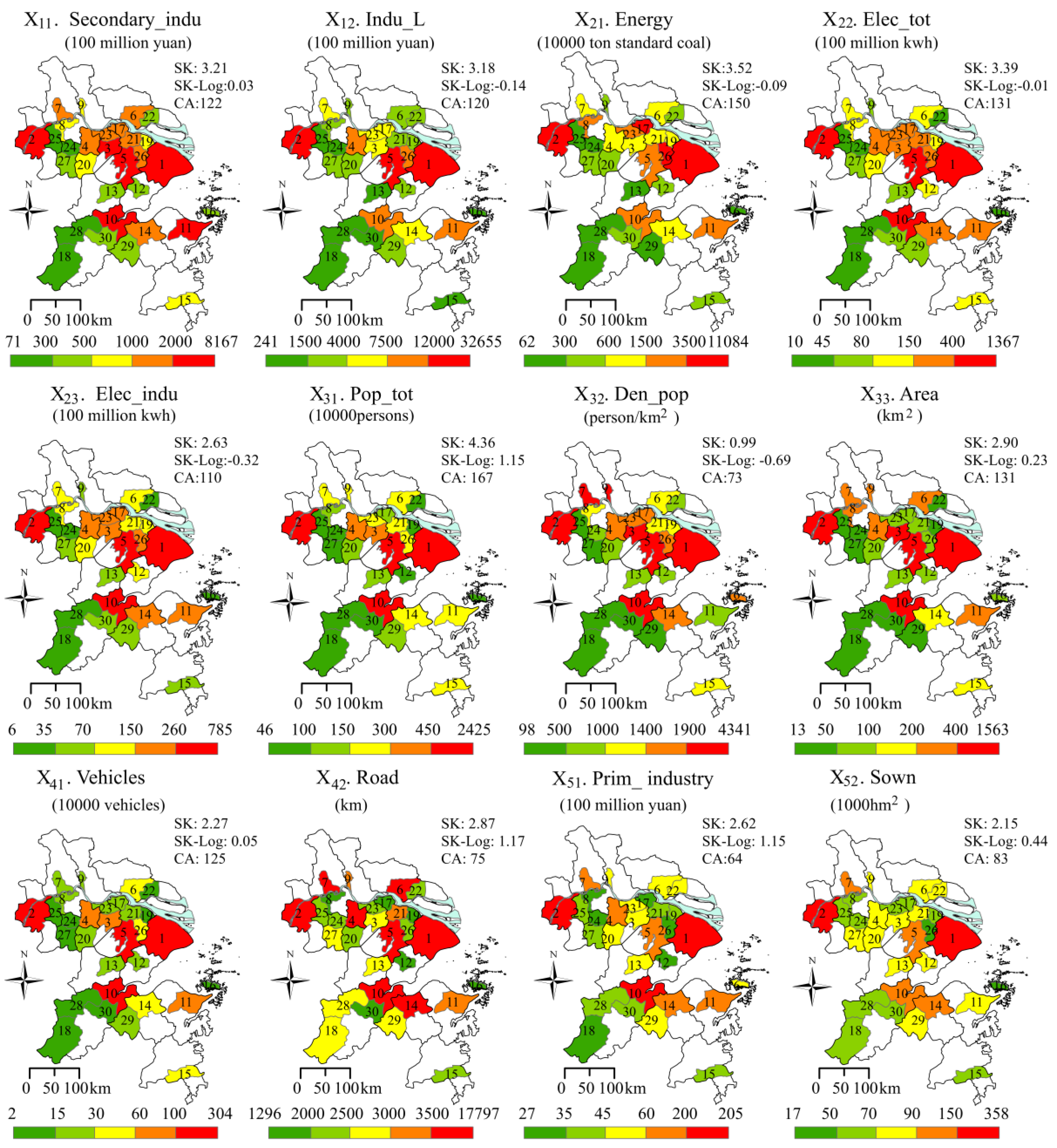
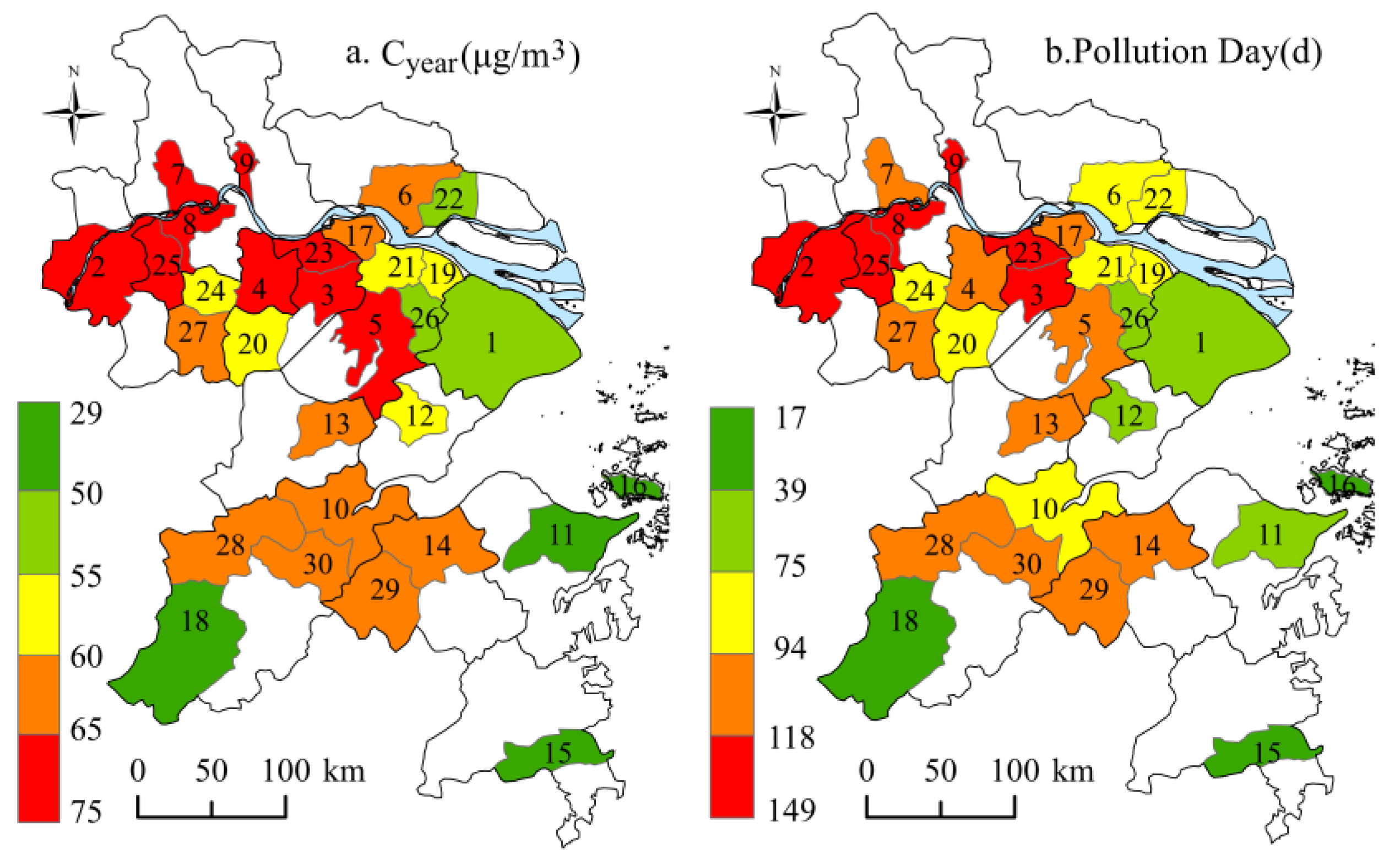
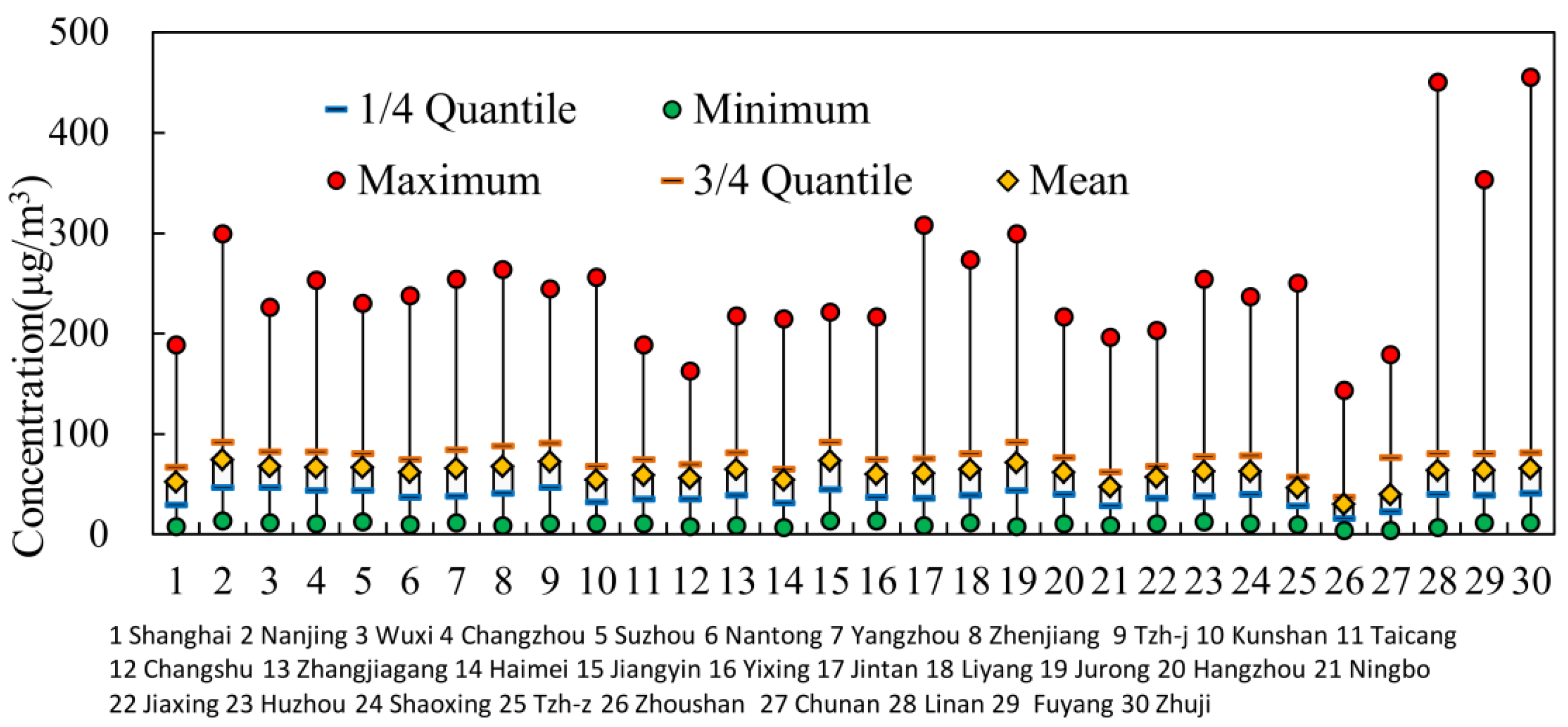
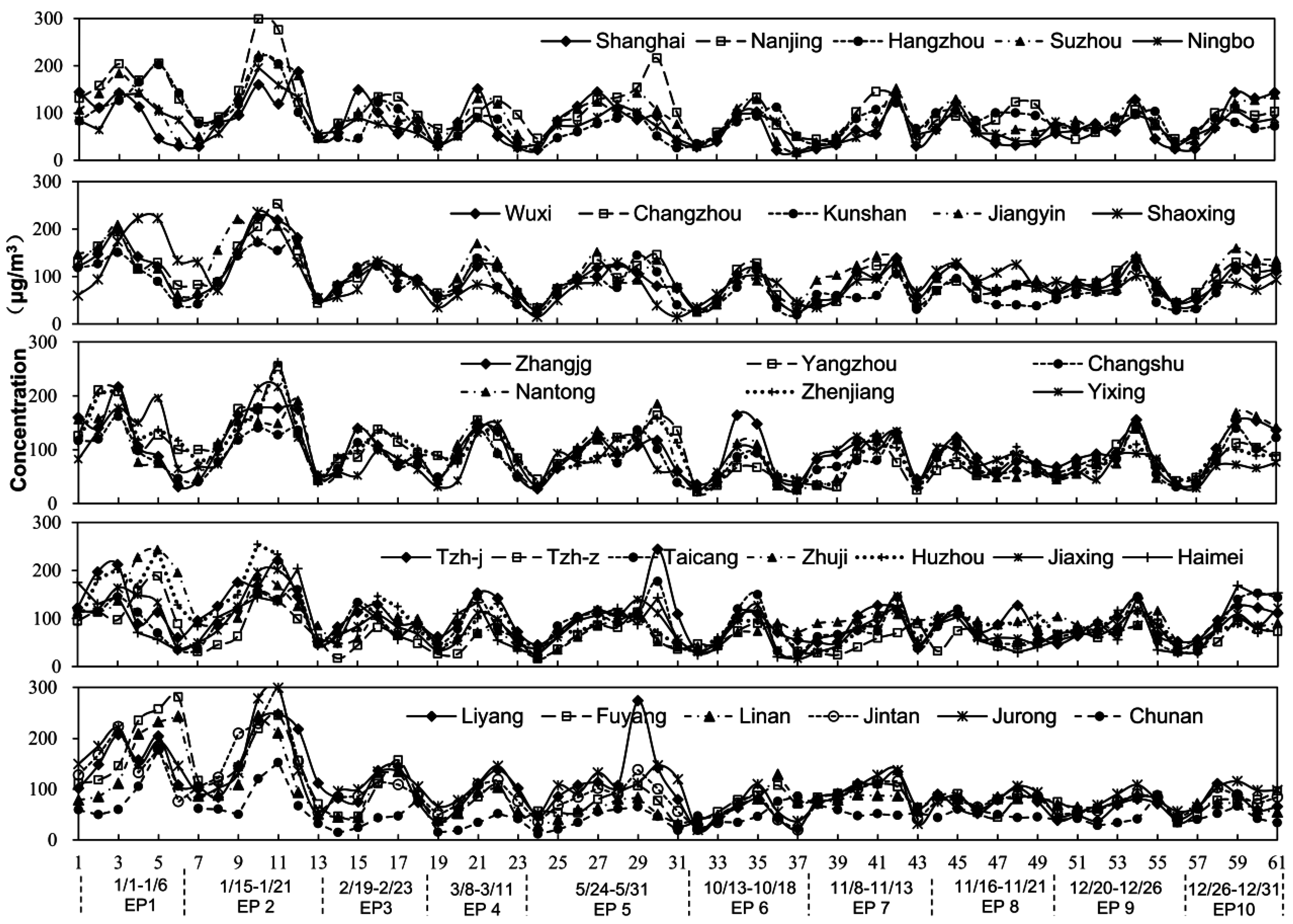
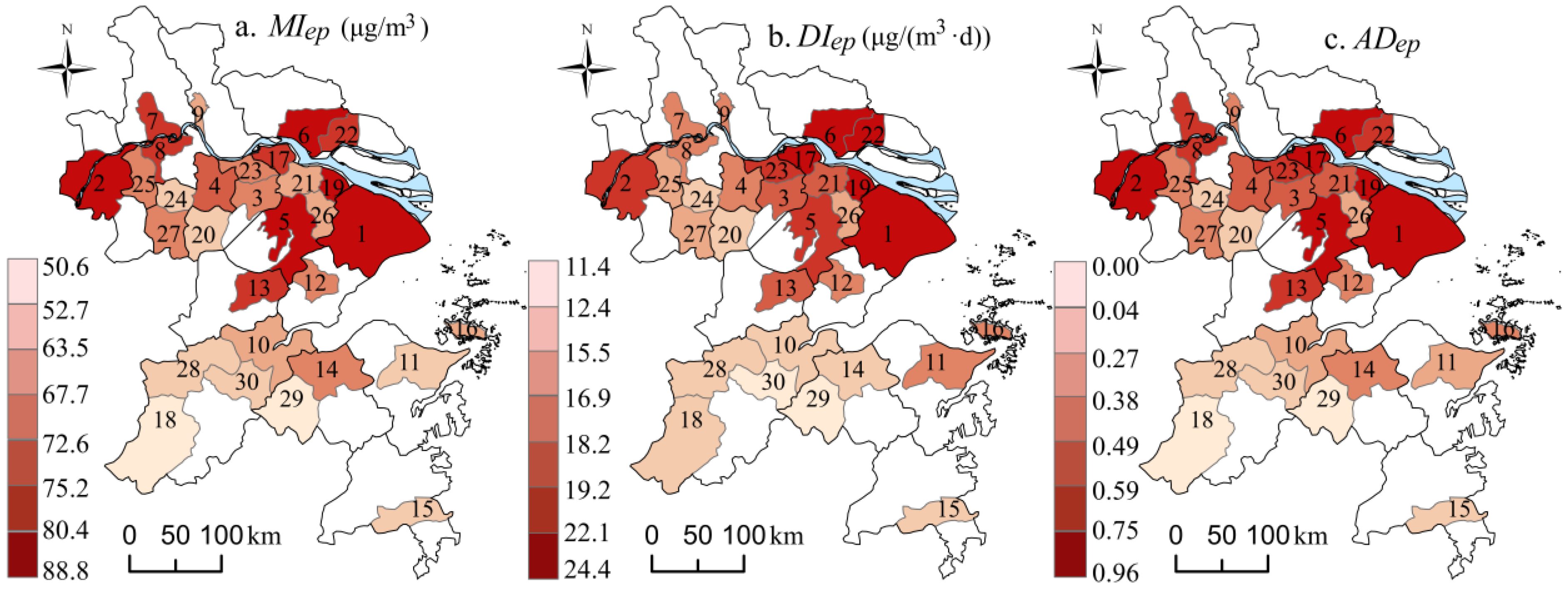
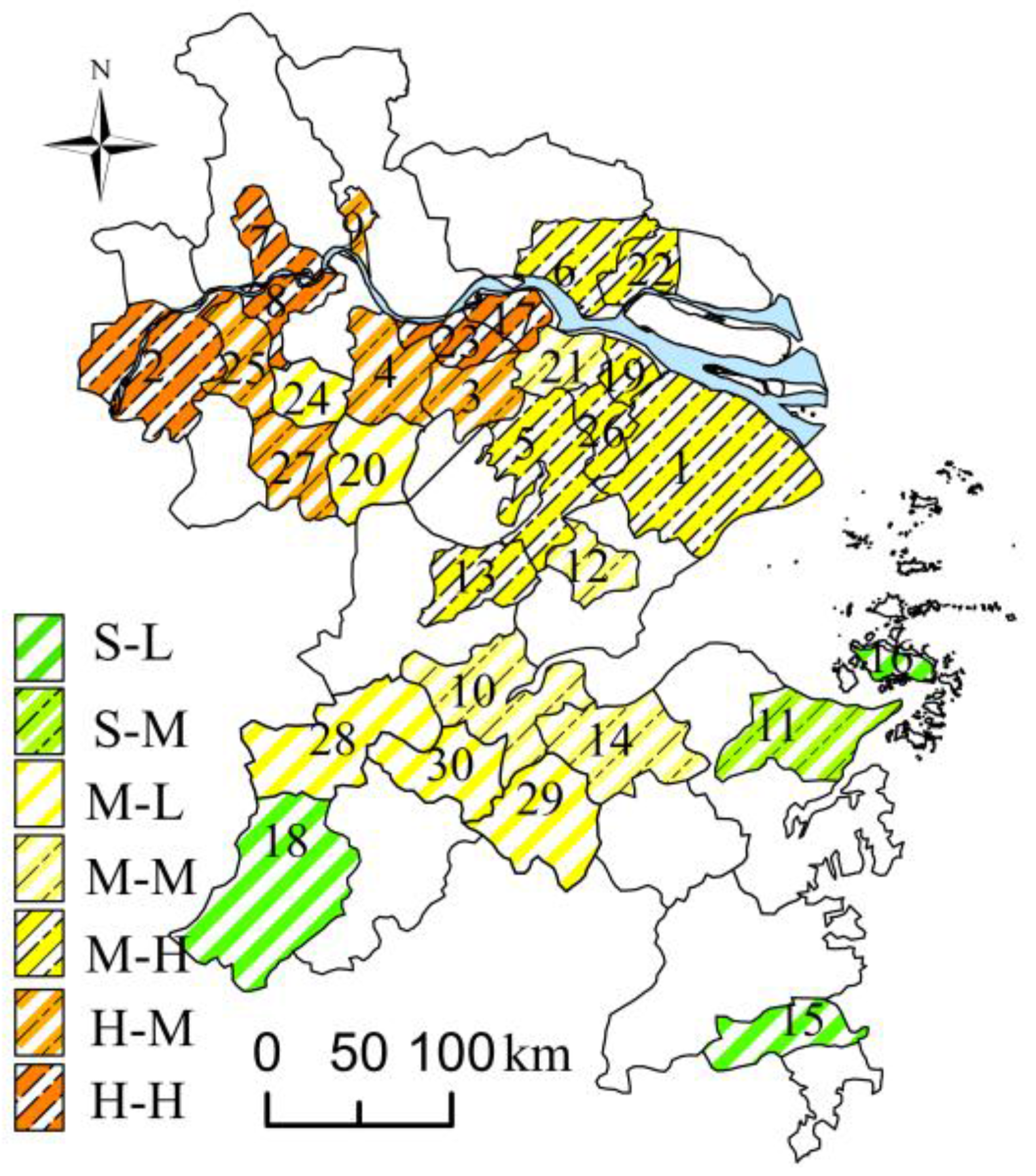
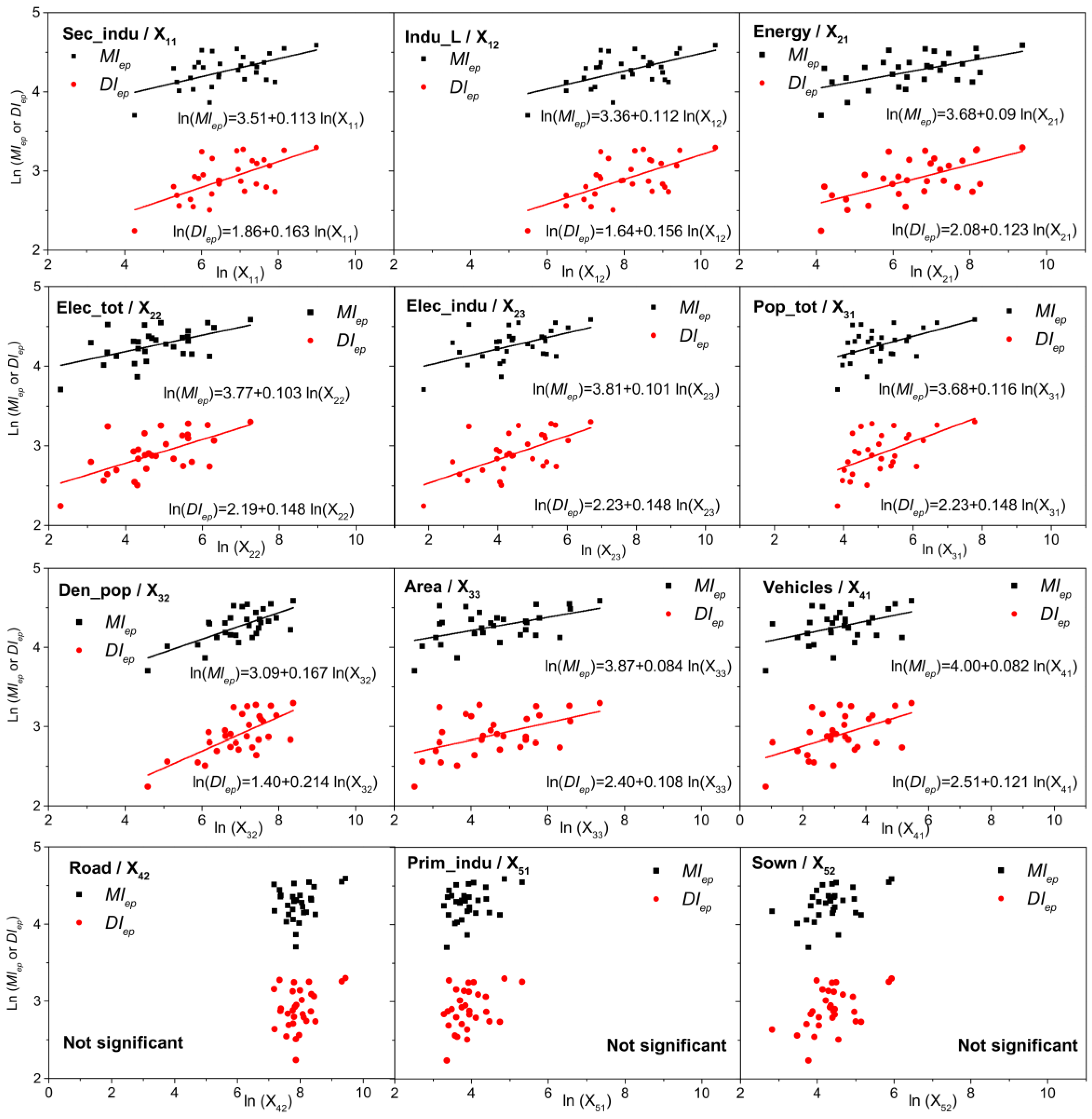
| Abbreviation | Interpretation of Indicators (Unit) | Max | Min | Mean | |
|---|---|---|---|---|---|
| Industrial factors | |||||
| Secondary industry/X11 | The secondary industry DGP (100 million yuan) | 8167 | 71 | 1258 | |
| Industry above size/X12 | Gross industry output value above designated size (100 million yuan) | 32,665 | 241 | 5098 | |
| Energy consumption | |||||
| Energy consumption/X21 | Total energy consumption (10,000 ton standard coal) | 11,084 | 62 | 1494 | |
| Electricity power/X22 | Total electricity power (100 million kWh) | 1367 | 10 | 205 | |
| Industry electricity/X23 | Industry consumption of electricity power (100 million kwh) | 785 | 6 | 145 | |
| Population and City | |||||
| Population/X31 | Permanent Resident Population (10,000 persons) | 2425 | 46 | 264 | |
| Population Density/X32 | Density of Population(person/km2) | 4341 | 98 | 1399 | |
| Built-up area/X33 | Area of urban Built-up (km2) | 1563 | 13 | 216 | |
| Transportation | |||||
| Vehicles/X41 | Possession of Civil Vehicles (10,000 vehicles) | 304 | 2 | 44 | |
| Road/X42 | Total length of roads (km) | 17,797 | 1296 | 3353 | |
| Agricultural factors | |||||
| Primary industry/X51 | The primary industry DGP (100 million yuan) | 205 | 27 | 58 | |
| Sown/X52 | Total sown area of crops (1000 hm2) | 358 | 17 | 98 | |
| Episode | Month | MIep | DIep | ADep | ||||||
|---|---|---|---|---|---|---|---|---|---|---|
| Min | Max | Mean | Min | Max | Mean | Min | Max | Mean | ||
| EP1 | January | 14 | 167 | 85 | 4.67 | 42.50 | 23.53 | 0.00 | 0.96 | 0.48 |
| EP2 | January | 80 | 217 | 144 | 21.09 | 55.42 | 32.92 | 0.06 | 0.98 | 0.40 |
| EP3 | February | 29 | 107 | 59 | 9.67 | 42.85 | 18.44 | 0.00 | 0.86 | 0.33 |
| EP4 | March | 36 | 131 | 83 | 9.37 | 40.04 | 22.57 | 0.01 | 0.94 | 0.46 |
| EP5 | May | 31 | 187 | 73 | 7.01 | 37.49 | 15.37 | 0.01 | 1.00 | 0.27 |
| EP6 | October | 43 | 129 | 79 | 9.73 | 43.09 | 20.77 | 0.02 | 1.00 | 0.37 |
| EP7 | November | 2 | 117 | 61 | 0.70 | 25.25 | 15.09 | 0.01 | 0.96 | 0.55 |
| EP8 | November | 3 | 56 | 24 | 1.43 | 28.00 | 10.46 | 0.00 | 1.00 | 0.36 |
| EP9 | December | 13 | 98 | 50 | 2.60 | 24.50 | 12.32 | 0.00 | 1.00 | 0.44 |
| EP10 | December | 2 | 141 | 69 | 0.78 | 46.94 | 22.07 | 0.00 | 1.00 | 0.47 |
| Average | annual | 54 | 90 | 72 | 13.46 | 25.67 | 19.38 | 0.00 | 0.96 | 0.26 |
| Pollution Sources | Detector Indicator | Pearson Coefficients | PD | ||||||
|---|---|---|---|---|---|---|---|---|---|
| Cyear | MIep | DIep | ADep | Cyear | MIep | DIep | ADep | ||
| Industry factors | Sec_indu/X11 | 0.18 | 0.56 ** | 0.62 ** | 0.58 ** | 0.13 | 0.27 | 0.37 | 0.36 |
| Indu_L/X12 | 0.34 | 0.54 ** | 0.61 ** | 0.55 ** | 0.19 | 0.26 | 0.31 | 0.32 | |
| Energy consumption | Energy/X21 | 0.19 | 0.55 ** | 0.61 ** | 0.58 ** | 0.12 | 0.30 | 0.32 | 0.31 |
| Elec_tot/X21 | 0.20 | 0.53 ** | 0.60 ** | 0.55 ** | 0.17 | 0.18 | 0.18 | 0.19 | |
| Elec_indu/X23 | 0.33 | 0.53 ** | 0.62 ** | 0.57 ** | 0.15 | 0.29 | 0.31 | 0.34 | |
| Population and city | Pop_tot/X31 | 0.22 | 0.46 * | 0.56 ** | 0.54 ** | 0.13 | 0.31 | 0.29 | 0.33 |
| Den_pop/X32 | 0.22 | 0.68 ** | 0.67 ** | 0.65 ** | 0.12 | 0.36 | 0.33 | 0.39 | |
| Area/X33 | 0.13 | 0.47 ** | 0.48 ** | 0.47 ** | 0.11 | 0.33 | 0.29 | 0.31 | |
| Transportation | Vehicles/X41 | 0.21 | 0.43 * | 0.50 ** | 0.46 * | 0.10 | 0.19 | 0.20 | 0.23 |
| Road/X42 | 0.23 | 0.32 | 0.31 | 0.31 | 0.09 | 0.18 | 0.19 | 0.22 | |
| Agriculture factors | Prim_indu/X51 | 0.15 | 0.25 | 0.29 | 0.27 | 0.12 | 0.21 | 0.14 | 0.18 |
| Sown/X51 | 0.34 | 0.36 | 0.37 | 0.36 | 0.18 | 0.23 | 0.17 | 0.22 | |
© 2016 by the authors; licensee MDPI, Basel, Switzerland. This article is an open access article distributed under the terms and conditions of the Creative Commons Attribution (CC-BY) license (http://creativecommons.org/licenses/by/4.0/).
Share and Cite
Lou, C.-R.; Liu, H.-Y.; Li, Y.-F.; Li, Y.-L. Socioeconomic Drivers of PM2.5 in the Accumulation Phase of Air Pollution Episodes in the Yangtze River Delta of China. Int. J. Environ. Res. Public Health 2016, 13, 928. https://doi.org/10.3390/ijerph13100928
Lou C-R, Liu H-Y, Li Y-F, Li Y-L. Socioeconomic Drivers of PM2.5 in the Accumulation Phase of Air Pollution Episodes in the Yangtze River Delta of China. International Journal of Environmental Research and Public Health. 2016; 13(10):928. https://doi.org/10.3390/ijerph13100928
Chicago/Turabian StyleLou, Cai-Rong, Hong-Yu Liu, Yu-Feng Li, and Yu-Ling Li. 2016. "Socioeconomic Drivers of PM2.5 in the Accumulation Phase of Air Pollution Episodes in the Yangtze River Delta of China" International Journal of Environmental Research and Public Health 13, no. 10: 928. https://doi.org/10.3390/ijerph13100928
APA StyleLou, C.-R., Liu, H.-Y., Li, Y.-F., & Li, Y.-L. (2016). Socioeconomic Drivers of PM2.5 in the Accumulation Phase of Air Pollution Episodes in the Yangtze River Delta of China. International Journal of Environmental Research and Public Health, 13(10), 928. https://doi.org/10.3390/ijerph13100928





